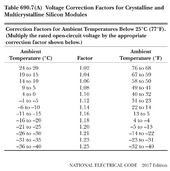Chio Antonius
New Member
Hey just joined to ask about the6000xp input voltage. Since the inverter has two pv inputs and each handles 17a each does that also mean that I can put 400v into each input? or is that input 1 and input 2 combined total not to exceed 480v? So 225v per input?
Suggestions please. I've learned a lot doing this myself but don't want to fry equipment or make assumptions that lead to mistakes. I am new and this system is off grid. I have battery and 11kw diesel gen.
Equipment:
9kw of 30 panels:
39.25 Voc
9.77 Isc
How can I max both inputs out on the 6000xp?
I tried 26 panels
2 strings of 6 panels each -> combiner -> input 1
235.5 voc -> 192.9 vmpp
19.54 isc -> 18.66 imp
with the same going to input 2.
2 strings of 6 panels -> combiner -> input 2
Should be around 3.4kw each input, correct?
It didn't get cold enough to rise over voltage point. Now the temperature is warming up with no cold mornings.
I did 11 in series alone to one input and it seemed to put some good juice through. Can I do that to both inputs??
I am gonna use all the juice it makes
Only have enough room for 26 panels as of now but can eventually use all 30.
How can I utilize this machine to its full potential?
How can I get 8kw (4000w each) or the whole 9kw (4500w each)
and stay under 480v?
Suggestions please. I've learned a lot doing this myself but don't want to fry equipment or make assumptions that lead to mistakes. I am new and this system is off grid. I have battery and 11kw diesel gen.
Equipment:
9kw of 30 panels:
39.25 Voc
9.77 Isc
How can I max both inputs out on the 6000xp?
I tried 26 panels
2 strings of 6 panels each -> combiner -> input 1
235.5 voc -> 192.9 vmpp
19.54 isc -> 18.66 imp
with the same going to input 2.
2 strings of 6 panels -> combiner -> input 2
Should be around 3.4kw each input, correct?
It didn't get cold enough to rise over voltage point. Now the temperature is warming up with no cold mornings.
I did 11 in series alone to one input and it seemed to put some good juice through. Can I do that to both inputs??
I am gonna use all the juice it makes
Only have enough room for 26 panels as of now but can eventually use all 30.
How can I utilize this machine to its full potential?
How can I get 8kw (4000w each) or the whole 9kw (4500w each)
and stay under 480v?




